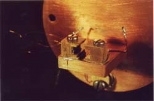At a ceremony at the MIT Museum last week, General Motors Corp. donated historic lead-salt diode lasers to the museum's Science and Technology Collection. The lasers were used in historic experiments sponsored by NASA and conducted at MIT Lincoln Laboratory in the early 1980s by scientists from Lincoln Lab and GM Research Laboratories (now GM R&D Center).
Lead-salt diode lasers are now used fields including isotope analysis, pollution monitoring, toxin detection, fiber optics communications, semiconductor processing, oil exploration, combustion diagnostics and explosives detection for law enforcement.
The story behind these lasers illustrates "the most basic and important tale in the history of science -- experimental proof of theories and the ability to reproduce those results," said Deborah Douglas, curator of science and technology at the MIT Museum.
In 1958, two giants of physics, Arthur Schawlow and Charles Townes, introduced an important new theory about the physics of lasers in a paper on optical masers that historians have called "the starting gun in the race to build the first laser." The scientific community accepted their theory of quantum phase noise, but no one could prove it experimentally.
The first laser, the ruby laser, was invented in 1960. With the invention of the first gas lasers, scientists now had a laser that would emit a continuous-wave beam. Researchers at MIT and Lincoln Lab began working on this kind of laser.
In 1966, Charles Freed (SM 1954, EE), a senior staff member at Lincoln Lab, developed an ultrastable carbon-dioxide gas laser. The first CO2 laser had been invented by C.K.N. Patel in 1963, but Mr. Freed's laser was developed differently. Initially, he modified the design of a helium-neon gas laser invented by Ali Javan (now professor emeritus of physics). Mr. Freed, impressed with the stability of the CO2 laser, immediately set out to improve his prototype. The resulting CO2 lasers were put to work right away in all sorts of experiments -- one of the most important of which was one to verify the Schawlow-Townes theory.
To prove the theory, Mr. Freed needed two different types of lasers in his experimental apparatus. He teamed up with Lincoln Lab colleague E. David Hinkley and Theodore C. Harman, who had developed some special lead-salt diode lasers. In 1968, they published the results of their work, to the immediate acclaim of the scientific community.
For the next 12 years, textbooks cited Hinkley and Mr. Freed and included their photographs to illustrate the Schawlow-Townes theory. But at a 1980 scientific conference sponsored by NASA Langley Research Center, several young scientists who had been unable to reproduce Mr. Freed's results challenged him. Mr. Freed, nonplussed, said he would be happy to demonstrate the experiment again.
GM-MIT COLLABORATION
In 1981, NASA Langley accepted Mr. Freed's formal proposal to verify the results of the earlier Hinkley-Freed experiment. There were some important changes, however. Mr. Freed proposed using an ultra-stable carbon-monoxide (CO) laser based on his earlier CO2 designs. Lincoln Lab stopped making lead-salt diode lasers in the mid-1970s, so he proposed using diode lasers developed by Wayne Lo of General Motors Research Labs' physics department. These lasers had the properties necessary for use in the planned experiment with Mr. Freed's CO laser.
GM had been developing lead-salt diode lasers and using them for exhaust gas analysis and in research studies of combustion, closed-loop engine control and air-fuel mixtures. In keeping with its history of fundamental as well as applied research, the GM Research Laboratories had also used diode lasers in saturation spectroscopy, opto-acoustic spectroscopy and atmospheric solar absorption studies. Because lead-salt diode lasers were notoriously difficult to operate, Wayne Lo's help in correlating the experimental results with theory was very important.
Mr. Freed and Dr. Lo made their first report to NASA Langley in February 1982. Not only had they been able to reproduce the results of the original Hinkley-Freed experiment, but with the new equipment, they achieved a fivefold improvement in fractional linewidth.
They also demonstrated that their results closely matched the newly updated theory of the Schawlow-Townes line width as it applied to lead-salt diode lasers. It was an even more convincing empirical demonstration of the theory, and the results stand to this day. Tragically, Dr. Lo died in an accident immediately following the successful experiment.
The laser donation "celebrates the work of two scientists who coupled the spirit of cooperation with their quest for knowledge," said Jamie Hsu, executive director of technical management at the GM R&D Center. "This is a true example of the power inherent in industry and academia partnering to speed scientific advancement."
"The MIT Museum is very pleased to accept these lasers to its Science and Technology Collection," said Jane Pickering, director of the museum. "A vital part of the MIT Museum mission is to document, interpret and communicate to a diverse audience the activities and achievements of the Institute. This gift is important for two reasons. First, we will be preserving an important and significant technology of the late 20th century. Second, we are adding two artifacts to the collection that remind us of the vital partnership between MIT and industry."
A version of this article appeared in MIT Tech Talk on November 15, 2000.







